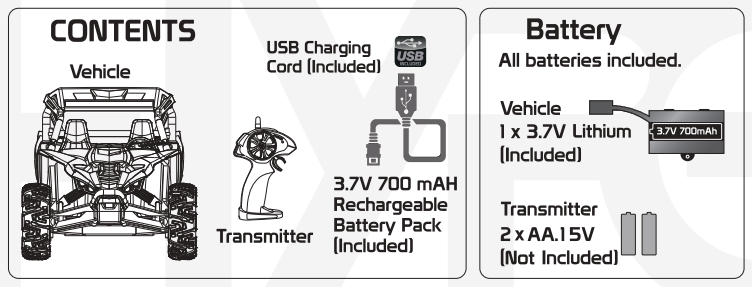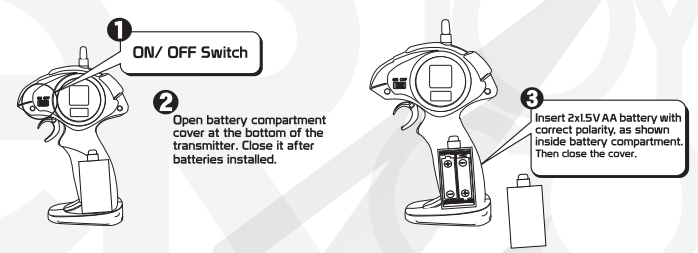Yamaha YXZ1000R Pure Sport Side By Side Instruction Manual
Pure Sport Side By Side YXZ1000R
Instruction Manual
CONTENTS

TRNSMITTER

Vehicle
TURNING ALIGNMENT
REMOTE INSTRUCTION
After Play
Battery Safety Information:
- Insure that battery polarity is correct. Use only batteries of the type recommended (or equivalent)
- Do not mix old and new batteries.
- Do not mix alkaline, standard (carbon-zinc), or rechargeable (nickel-cadmium) batteries.
- Rechargeable batteries are to be removed from the product before being charged.
- Rechargeable batteries are to be recharged by Adult only. Remove used-up batteries immediately.
- Do not recharge non-rechargeable batteries. Do not short-circuit terminals. Dispose of batteries safety.
- Do not dispose of batteries (or products containing non-rechargeable batteries) in fire, as batteries may explode or leak.
FCC Statement
This device compels with industry Canada licence-exempt RSS 210 standard. Operation Is subject to the following two cord lOons: (1) this device may not cause Interference. and (2) this device must accept any interference. including interference That may cause undesired operation of the device.
This device complies with the Part 15 of the FCC rules.
Operation is subject to the following two conditions:
(1) This device may not cause harmful interface, and
(2) this device must accept any interference received, including interference that may cause undesired operation.
Caution: changes or modifications not expressly approved by the party responsible for compliance could void the user’s authority to operate the equipment.
NOTE: This equipment has been tested and found to comply with the limits for a Class B digital device, pursuant to Part 15 of the FCC Rules. These limits are designed to provide reasonable protection against harmful interference in a residential installation.
This equipment generates, uses and can radiate radio frequency energy and, if not installed and used in accordance with the instructions, may cause harmful interference to radio communications.
However, there is no guarantee that interference will not occur in a particular installation. If this equipment does cause harmful interference to radio or television reception, which can be determined by turning the equipment off and on, the user is encouraged to try to correct the interference by one or more of the following measures:
- Reorient or relocate the receiving antenna.
- Increase the separation between the equipment and receiver.
- Connect the equipment into an outlet on a circuit different from that to which the receiver is connected.
- Consult the dealer or experienced radio/TV technician for help.